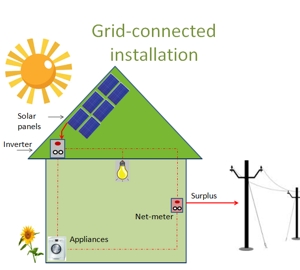|
In América Fotovoltaica we use an on-line
analytical system for photovoltaics which interacts with
Google maps to determine your exact location, and with
NASA to obtain the solar irradiation data specifically
of your site. Doing so we can produce a very accurate
solar installation analysis in just a few minutes from
our desktop. Based on the aerial images available to
us we will size the dimensions of your installable area
and therefore determine the number of solar panels that
can be mounted.
See below an example of the aerial image used by América
Fotovoltaica to estimate the roof potential of one of
our clients.

Diligencie el formulario
General aspects of
a photovoltaic installation in
Colombia:
Solar photovoltaic systems can be used for homes,
offices, public buildings, car parks or remote sites.
They can be installed on roofs, terraces or on building
facades or operate as stand-alone systems.
A photovoltaic installation can be either connected to
the electricity grid (so called grid connected) or
stand-alone (off-grid). The former one could allow any
excess electricity production to feed the electricity
grid and to sell it to the utility company. In Colombia
this option (called Net Metering) is now a reality
thanks to the recently enacted Law 1715 of May 2014.
Off-grid
or stand alone photovoltaic installations have no
connection to an electricity grid, and are contributing
to rural electrification in many developing countries.
These stand-alone systems have a storage battery for
supplying the electric energy when there is no sunlight.
 Key components of a photovoltaic (solar) installation: Key components of a photovoltaic (solar) installation:
Photovoltaic modules which are simply an assembly of
solar cells, which in turn are semi-conductor components
that convert the solar energy into direct electric
current.
Inverter, responsible for converting the direct electric
current produced by the photovoltaic cells into
alternating current available for electric devices.
Batteries, which store the electricity while it is
generated for use at night when no more sunlight is
available.
An off-grid photovoltaic system can clearly work without
batteries, in which case it provides electricity that
can only be consumed immediately for it not to be lost.
Moreover, a grid connected installation in Colombia has
the ability to sell any production surplus that is not
used immediately to the electricity system, creating a
virtual credit that can be used at a later moment. As
such, the net metering possibility implies that the use
of batteries is not needed any longer.
Solar charge controller, which regulates the flow of
electricity from the photovoltaic panels to the
batteries and protects them against overcharge (when the
panels are producing energy which is not consumed).
|